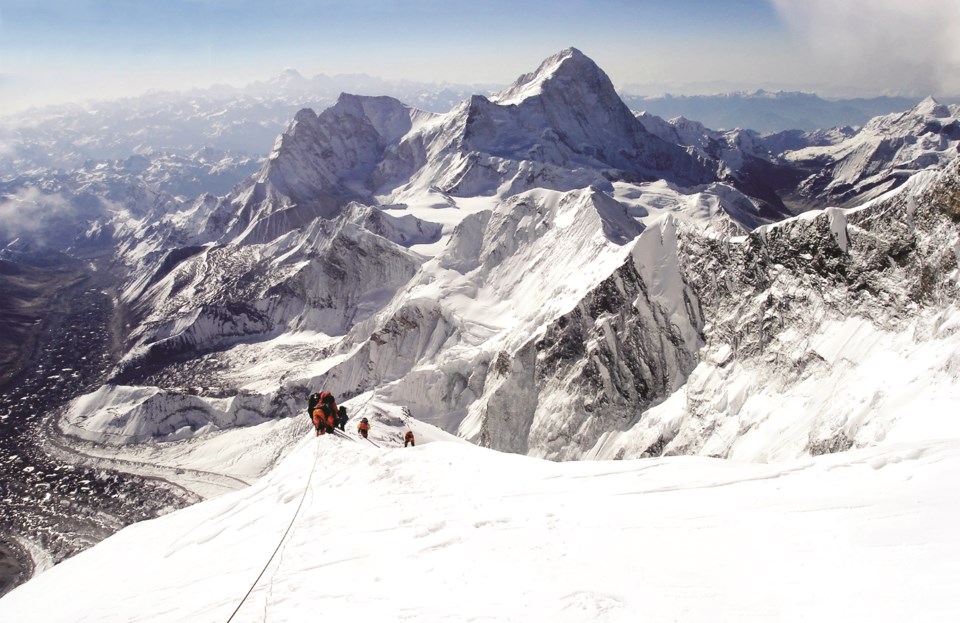I’ll be first to admit I haven’t read all the classic books of mountain accounts. I did make most of my way through Mountaineering: The Freedom of the Hills, which is largely considered the handbook for climbers and mountaineers. First published in 1960 by The Mountaineers (alpine club) of Seattle and now in its ninth edition, Freedom of the Hills is a must for anyone looking to get serious in the mountains, in any season undertaking any activity. While there is some foreword on the appeal of mountains (besides another John Muir cliché), this is a handbook, not a novel.
The survival story that most could recall is Touching the Void, but like many, I skipped the book and watched the re-enacted 2003 film documentary instead. British climber Joe Simpson tells a harrowing story of how he broke his leg while descending from the summit of Siula Grande in Peru in 1985. Long story short, while being lowered by his climbing partner Simon Yates on a rope, Simpson fell again through a cornice and the pair was completely out of communication. Yates had to make the call of cutting the rope or allowing both of them to perish off the edge. Simpson somehow survived the fall and over the next three days, crawled and hopped back to base camp right before Yates left to return to civilization. There was a lot more that went on, of course, and a lot of what I just described requires the proper context, all of which you can read or watch in Touching the Void.
The most recent book I read didn’t quite have that level of against-the-odds survival in the mountains, but was still both inspiring and affirming. A while back a friend handed me a copy of No Shortcuts to the Top: Climbing the World’s 14 Highest Peaks by Ed Viesturs, the first American to climb all 14 of the world’s eight-thousander peaks (mountains that have summits that reach more than 8,000 metres above sea level). He was the fifth person to do so in the world without bottled oxygen (what many high-altitude mountaineers describes as “doing it properly”) and he summited Mt. Everest a total of seven times in his career.
While I don’t plan on embarking on any mountain climbing expeditions to the Himalaya in my life, I learned a great deal from Viesturs’ autobiography. The most resounding quote I read was: “Getting to the top is optional. Getting down is mandatory.” Embarking on an adventurous ski objective should be thought of exactly the same way; one must survive the slope you want to ski, but you also need to leave enough time and energy to safely make it home.
Viesturs of course made his own missteps earlier in his career, the biggest was agreeing with his partners to push for the summit when he had a sinking feeling it would put them all at risk.
“Yet nothing would ever convince me that pushing on to the summit of K2 on August 16, 1992, had been anything other than a mistake,” he wrote. “Today, I regard it as the biggest mistake of my climbing career. What I learned from that episode has stayed with me for good. Your instincts are telling you something. Trust them and listen to them.”
I have a better handle on human factors these days, but more than once in the past I’ve been talked into skiing something where my gut was telling me to turn around. I’m a lot more adamant about listening to that gut feeling now—group dynamics be damned—but it’s always good reinforcement to hear it from one of the world’s most successful (and still living) mountaineers.
While Viesturs’ relatively low-risk tolerance didn’t lead to any harrowing personal survival stories on the level of some other mountaineering novels, over those 18 years of pursuing his “Endeavor 8000” he bore witness to plenty of summit bids gone sideways. The worst was the 1996 Everest disaster, when eight climbers (including three guides) died after being caught in a storm descending from the summit. The incident had a lot to do with the number of people waiting their turn to (safely) make it to the top, the bottleneck causing dangerous delays. The incident raised questions about the commercialization of Everest. Viesturs was working with a separate group filming for the 1998 Imax film Everest and lost two good friends during that expedition. Journalist Jon Krakauer was on assignment with Outside magazine and was climbing with one of the guided groups; his book Into Thin Air describes the 1996 disaster in detail and is a bestseller.
The point of this pseudo book review is that while our relatively small mountains in B.C. don’t always pose the same dangers of 8,000-metre peaks in the Himalaya, skiers can fall into the same traps of underestimating their objectives. The best life in the mountains is the one long-lived. It took Viesturs almost 20 years to reach his goal, and that patience and risk aversion is what kept him alive and able to see his three children grow up.
Winter is a while away, but training one’s mountain mindset should be a year-round activity.
Vince Shuley prefers alpine style to expedition style. For questions, comments or suggestions for The Outsider email [email protected] or Instagram @whis_vince.





